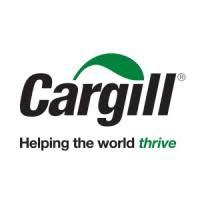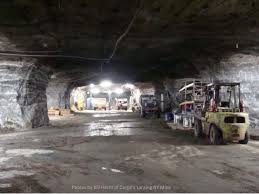LANSING, July 19, 2021 — As Cargill Inc. mines salt under sections of Cayuga Lake where thinning bedrock heightens the risk of a roof collapse or flood, the Cuomo Administration has doubled down on its longstanding practice of withholding key mine safety documents.

Last week the state Department of Environmental Conservation refused to provide a copy of a letter it received from Cargill in which the company committed to avoid mining around an area of particular rock weakness known as the Frontenac Point Anomaly, or FPA.

The letter was the basis for the DEC’s decision to amend to Cargill’s permit in February to better assure the structural integrity of the vast mine, which covers about 3,000 leased acres of state-owned property 2,300 feet beneath the surface of the lake.
“By letter, Cargill has agreed to not mine under the FPA and to maintain a minimum 1,000-foot setback from the FPA,” the agency stated in a public notice of its intent to impose the new restriction.” The new (permit) condition memorializes the letter.”

But the revised permit provides no definition of the FPA. Last week, the DEC refused WaterFront’s requests to specify the boundaries it recognizes for the anomaly. It also declined to release the Cargill letter.
Tens of millions of dollars in potential mining revenues are riding on where anomaly boundary lines are drawn, according to a lawsuit filed in Tompkins County Supreme Court last month against the DEC and Cargill.
Maps by Cargill mining consultants are not consistent in their depiction of the FPA.
For example, one 2018 map shows the FPA as an oval shape just outside the company’s mining activities. But a 2016 Cargill map shows the FPA as a line — possibly a fault — about five times longer than the oval. (See map, above).
As depicted, the line extends deep into areas Cargill has already mined. And a 1,000-foot setback from that line would impinge on areas the company plans to mine soon.
By omitting any definition of the FPA in its revised permit, the DEC may be allowing Cargill to choose its “preferred” version, according to the lawsuit.
The plaintiffs seek to block Cargill from further mining under both versions of the FPA — with setbacks — as well as under “the continuous trough of thinning bedrock” that extends across five other anomalies, pending a thorough review in compliance with the State Environmental Quality Review Act (SEQRA).
The DEC, as a matter of policy, declined to comment on the lawsuit.

Minnesota-based Cargill is the nation’s second largest private company with annual revenues of more than $110 billion in 2020.
Kevin G. Roe, Cargill’s attorney in the recent lawsuit, did not respond to an email request for comment on the suit and for a copy of the Cargill letter “memorialized” in the DEC’s permit amendment. Cargill’s formal response to the lawsuit is due July 26, and an oral argument in the case is set for Aug. 9.
John K. Warren, a geologist hired by plaintiffs as an expert witness, noted that Cargill consultants have repeatedly reported faults near the FPA.

Warren, the author of a 2017 study on salt mine leaks, said those faults under Cayuga Lake contribute to subsidence, where “the bedrock above a large underground void such as a salt mine will gradually sag down into the void.”
Warren said the “trough of anomalies” under Cayuga raises the risk that sagging bedrock will create apertures for water seepage.
“As these pre-existing fractures and openings change, the pathways for groundwater and brine change, and the mechanical strength of the bedrock above the mine also changes,” Warren wrote in a court-filed affirmation in June.
The lawsuit was filed by the Ithaca-based group CLEAN (Cayuga Lake Environmental Action Now) and several individuals who claim they have a lot to lose if the bedrock cracks and the mine floods. Any hydrologic connection between the salt mine and the lake could raise the salt concentration in the lake dramatically.

“I am concerned that my property values will be severely affected when our lake becomes salinized by virtue of a ‘mistake’ that Cargill makes while mining on or into fault lines or other anomalies,” said Louise Buck, a plaintiff who owns property on the lake’s eastern shore. “This will affect my legacy to my sons and their families, and we will be the poorer for it.”
Buck, who holds a doctorate from Cornell in natural resources management, said she is alarmed by “the inexplicable level of risk that the DEC appears to be tolerating in the face of this industry’s activities.”
For the past decade, Gov. Andrew Cuomo’s DEC has routinely deferred to Cargill’s efforts to resist public scrutiny.
For example, the agency has never required the company to prepare a full environmental impact statement (EIS) that explores the potential for a mine flood. American Rock Salt, Cargill’s chief competitor for state contracts for rock salt to de-ice winter roadways, has twice been ordered to prepare an EIS.
In 2015, the DEC allowed Cargill to separate two related mining projects to avoid an EIS on either one — a 150-acre tunnel under dry land and a mine shaft that needed the tunnel to connect to the salt mine.
In its Environmental Notice Bulletin, the agency misrepresented the tunnel project to the public when it stated: “All activities … will take place underground, and there will be no additional surface development associated with this proposal.”

Cargill had purchased the site at the end of the tunnel three years earlier. And as soon as the statute of limitations for legal challenges on the tunnel project expired, Cargill promptly applied for a permit for the mine shaft.
While SEQRA specifically prohibits segmentation of projects that are inherently related, a Tompkins County Supreme Court judge ruled that the DEC had properly separated the two projects. The suit, which had sought a court order compelling a full EIS, was dismissed.
Earlier this year, the DEC voluntarily relinquished management control over Cargill’s consultant on the Cayuga mine, John T. Boyd Co.
“Cargill has paid for DEC’s consultant since about 2002,” the recent lawsuit states, “but this consultant has always — until February of this year — reported directly to DEC.”
Now it reports to Cargill.
The change will make access to “mine-related documents” under FOIL (Freedom of Information Law) — already heavily restricted — even more limited, according to John Dennis, another plaintiff in the case.
In its notice to the public, the DEC downplayed both its new permit condition for the FPA and its altered relationship with Cargill’s main consultant as “mostly housekeeping changes.”

Plaintiffs Louise Buck and William Hecht, a geologist, said turning over management of the third-party consultant to Cargill introduces “an unacceptable conflict of interest.”
The 2018 map that depicted the FPA as an oval, giving Cargill maximum mining leeway, was produced by that consultant, John T. Boyd Co., as part of a 2018 letter to the DEC.

For two decades, Hecht has waged campaigns to pry loose mine safety documents that the DEC has withheld based on Cargill’s assertion that they are confidential “trade secrets.”
In 2003, two administrative law judges at the DEC concluded that Cargill had failed to carry its burden of proof, giving Hecht an apparent victory.
“Strong policy considerations support the release of information in this case,” James McClymonds, the agency’s chief ALJ wrote. “Shielding from public scrutiny the very information necessary to assess the potential environmental impacts associated with a proposed mine is inimical to that process.”
But MyClymonds was overruled months later by an assistant DEC commissioner, and many documents at issue have remained under seal.
In an affidavit in the recent CLEAN lawsuit, Hecht said:
“Have we learned nothing? The DEC must stand up and protect the resources of New York they hold in trust for future generations.”
Hecht asserts that Cargill should be required to prepare an EIS that covers the decommissioning of the mine.
Raymond Vaughan, a geologist from Buffalo and expert witness in the lawsuit, said thinning bedrock and rock faults around the FPA pose “a risk to mine stability and integrity.”

He said the need for protection against those risks is based on lessons learned from the 1994 roof collapse at Akzo’s Retsof salt mine in Livingston County, which had been in operation for about a century. That incident 90 miles west of Cayuga Lake led to the complete flooding of the largest salt mine in North America.
Until recently, Cargill had operated three major rock salt mines in the United States: the Cayuga mine, a mine near Cleveland and a mine in Louisiana.
In December, a roof collapse at the Louisiana mine on Avery Island trapped 18 miners underground. While 16 escaped, two men died. Six weeks later Cargill announced plans to permanently close the mine it had operated for 24 years.
A preliminary accident report filed by the federal Mine Safety and Health Administration said Rene J. Romero Jr. and Lance Begnaud had been drilling in a section of the mine when the roof fall occurred. The MSHA has not completed its final report on the incident.
The Louisiana mine employed 200, roughly the same number currently employed at the Cayuga mine.


Thank you Peter for doing the digging and clear reporting that helps us begin to know about protecting the Finger Lakes. Many of us wish the environmental agencies would act on our behalf without undue influence from political leaders, but that is not yet the case. Independent watchdogs will need to be protected, supported, and chartered to publish all of their findings.
LikeLike
DEC’s withholding is short-sighted if not plain stupid.
LikeLike
Seneca Lake and Cayuga Lake are linked by the Cayuga-Seneca Canal – The Erie Canal. If we lose Cayuga (God Forbid) what happens to the rest of the ecosystem. How is this building back better if there is no transparency and so much at risk? Is ANYONE paying attention at the DEC? Does anyone care? I think there is something more going on than political contributions here with Cargill. It think its time dare I say that we involved the Federal Government to investigate why big business always seems to trump (no pun intended) the citizens of this region and the environment.
LikeLike
Thank you for your work Peter, hopefully the light you shine on these issues will move us all to engage our energies to correct bad practices–we all have a part to play.
LikeLike